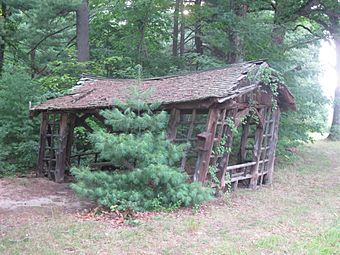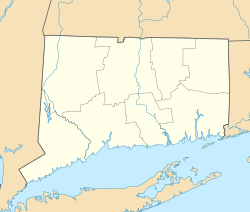Shade Swamp Shelter facts for kids
Quick facts for kids |
|
|
Shade Swamp Shelter
|
|
 |
|
| Location | US 6 E of New Britain Ave., Farmington, Connecticut |
|---|---|
| Area | 6.5 acres (2.6 ha) |
| Built | 1934 |
| Architect | Civilian Conservation Corps |
| Architectural style | Rustic |
| MPS | Connecticut State Park and Forest Depression-Era Federal Work Relief Programs Structures TR |
| NRHP reference No. | 86001746 |
| Added to NRHP | September 04, 1986 |
The Shade Swamp Shelter is a cool old building in Farmington, Connecticut. It's a special kind of shelter that looks very natural, like it's part of the forest. It was built way back in 1934 by a group called the Civilian Conservation Corps (CCC). This shelter is a great example of their unique building style, known as "Rustic architecture." Because it's so important, it was added to the National Register of Historic Places in 1986.
Contents
What is the Shade Swamp Shelter?
The Shade Swamp Shelter is found in a quiet, mostly country area of Farmington. It sits at the edge of the Shade Swamp Wildlife Management Area. This is a huge state-owned natural space, about 174 acres big! The shelter is right next to a small parking area. This spot is also the start of a "Blue-Blazed Trail" that leads into the wildlife area.
How Was the Shelter Built?
The shelter is made from logs, using a simple "post-and-beam" style. This means it has strong vertical posts and horizontal beams. The corners have a cool criss-cross pattern, and there are diagonal supports to make it extra strong.
Inside, the floor is made of flat stones called flagstone. There's also a rustic bench built all around the edges, perfect for resting. The roof is held up by more logs and covered with wooden shingles. A really special part is the ceiling inside. It's decorated with white birch logs arranged in a zig-zag pattern, like a "chevron." This unique design isn't seen in other buildings made by the CCC in Connecticut.
History of the Shade Swamp Shelter
The state of Connecticut started buying parts of the Shade Swamp area in 1926. They wanted to create a special place for wildlife.
Who Built the Shelter and Why?
The Shade Swamp Shelter was built in 1934 by the Civilian Conservation Corps (CCC). The CCC was a program during the Great Depression. It helped young men find work by building parks, trails, and other public projects. They built this shelter as part of a plan to create trails in this natural area, which wasn't used much at the time.
Even though the shelter is in a public spot and you can see it from the road, it's still in great shape today. Its unique ceiling design makes it stand out from other CCC buildings in the state.



